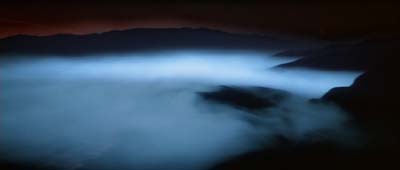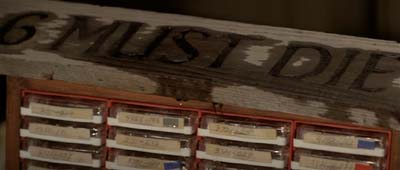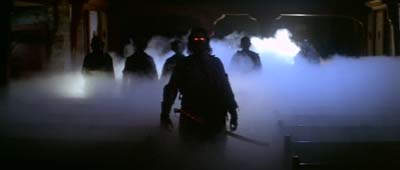The Fog
"There's something in the fog!" warns Stevie Wayne. Better get the washing in then...

The process of taking screenshots is a joy when you're reviewing a John Carpenter movie because there are so many powerful images to choose from. Where it gets more difficult is in trying to convey the sheer atmosphere he creates in his better films using only words. Carpenter is a man who likes to build tension through ambience, and when you're dealing with films like The Fog there are few words qualified enough to do the job.
Made in 1979 when Carpenter was really beginning to gain confidence in his work, The Fog sees him shift focus from the urban tension and horror of Assault On Precinct 13 and Halloween to a more supernatural (and in many ways more difficult) leaning. Antonio Bay in northern California is a typically quiet, sleepy little coastal town inhabited by fishermen and other blue-collar types that harbours a dark secret from it's past. Upon it's creation a hundred years previously, the founding six members of the community took exception to the arrival of a diseased ship whose crew intended to form their own leper colony close by. Luring them to shore with a fire late at night, the six caused the ship to be dashed on the rocks, drowning the crew, and by the light of day salvaged their gold from among the wreckage. As the town now gears up to celebrate it's centenary year, a dense fog appears off the coast, travelling against the wind and causing all manner of spooky occurrences, not least of all the death of a local trawler's crew.
The Fog begins as it means to go on, opening with a spooky little sequence where an old man is telling kids around a campfire creepy tales of local mysteries, and it's here that we are introduced to the story of Captain Blake and his ill-fated crew. The eerie tension of this scene alone is a hundred times more effective than most other modern horror films in their entirety, and it's a pretty good indicator of the mood you can expect throughout the rest of the movie.
The actions shifts into town where Stevie Wayne (Adrienne Barbeau), DJ for the local lighthouse-based radio station KAB receives a warning from her meteorologist husband of a dense fog bank heading in from offshore. A warning is put out to the aforementioned crew of the local trawler 'Seagrass', but the fog is moving too rapidly for them to change course, and soon they are enveloped in the eerily glowing mass. Understandably surprised at the appearance of what looks to be an old galleon, the Seagrass boys fail to notice the undead assailants who've just boarded and proceed to bloodily butcher them. Yowzer.
Meanwhile, local man Nic Castle (Tom Atkins) stops to pick up hitch-hiking Elizabeth Solley (Jamie Lee Curtis) and the pair are understandably perturbed when all of the windows in Nick's pickup implode for no good reason. It seems similar things are going on all round town, not least of all up at the church where Father Malone makes the discovery of his grandfather's journal. The log reveals how Malone's ancestor was one of the six founders who killed Blake and his crew, and he and his guests councilor Kathy Williams (Curtis' mother Janet Leigh) and her assistant Sandy Fadel (Nancy Loomis) start putting two and two together, realising that Blake and his men want not only their gold back, but also revenge on the descendants of their killers. The fog disappears at 1am, but Blake's work is only partly done...

It's a hokey little story, but in the hands of Carpenter it's also an extremely effective one. The movie's pacing is textbook stuff, instilling an early sense of foreboding and gradually building up to the intense finale. The mood is at times so intense you could cut it with a knife if your hands weren't shaking so much. The first time I saw The Fog was on television some years ago. I made the mistake of sitting down to watch it in the early hours of the morning in an empty house and I must confess those ninety minutes of suspense left me paranoid about going to bed at night for weeks. Carpenter moulds a simple story into so much more than the sum of it's parts, and it's seldom we see what is ostensibly a standard slasher flick achieve such great heights.
Part of this is undoubtedly due to his refusal to adhere to the traditional aspects of the genre. The violence in the film is notable largely due to it's absence. Carpenter is a director who truly appreciates the power of imagination, and he knows only too well that what we don't see is often worse in our minds than that which we do. As such, although we're dealing with hook-wielding supernatural psychopaths, there's actually very little blood, if any, on display. The terror comes instead from a psychological assault as Carpenter piles on the unsettling visuals and his usual intense homegrown musical score.
Of all the visual cues the fog itself is the most impressive. The director is well documented as saying he wanted the fog to be a character in itself, and to the credit of the effects team they certainly pull it off. Long shots of the glowing bank sweeping across the bay are matched by closer camerawork as it rolls out from the treeline of woods and creeps from under doorways, unseen by it's next victim. Stevie Wayne's assertion that "there's something in the fog" would be bad enough, but the fog itself is as menacing as any number of Jason Vorhees rip-offs, let alone the terror shrouded within.
Another personal highlight is the disturbing events surrounding Wayne's son's discovery of a plank on the beach engraved with part of a ship's name. Upon returning to the lighthouse where a selection of radio jingles is looping on a cassette player in the background, the wood begins to ooze seawater like blood, and the engraving changes to an altogether more sinister message, accompanied by the tape warping and a haunting voice replacing the jingles. Scary stuff indeed.
Carpenter's own minimalist score is implemented as in his other films to great effect, with simple piano ditties and synth chords complementing and adding to the overall feeling of impending doom. Although everyone seems to allude more to his use of music in Halloween, it works equally as well here and the film would have been a lot worse off without it.

There are many, many other nuances to The Fog which rather than being discussed deserve to be discovered. Each adds immensely to the overall atmosphere, of which I cannot make enough praise. Viewing the movie again now (and, I must add, safely by the light of day), it's true that some of the impact has been lost, but it's still an upsetting experience. For anyone who still hasn't seen it, however, what a treat awaits.
The recent trend for self-aware, 'post-modern' (I hate that goddamn expression) slasher pics that chop up naive teens in full gory view then turn to knowingly wink at the audience has diluted what was once an artform in it's own right. The sinister has been replaced by the overtly violent where nothing is left to the imagination, and suspense is built up not by score, lighting, camera work and steady pacing, but by bloodily killing off the person who you thought was the killer in favour of an otherwise quiet character with some horribly contrived motive. Other than Ring (the original, not the remake), I struggle to think of a horror movie in the last ten years which actually upset me, yet go back twenty and you've got a raft to choose from, many by Carpenter.
If, like me, you're fed up of Hollywood's recent exploitative insistence that violence alone is scary, take a trip back in time to circa 1980. You'll find a deluge of movies which can genuinely be classed as 'horror', and somewhere near the top of that list you'll find The Fog. It's 90 minute running time is easily more of a 'scream' than 6 hours of a certain recent trilogy I could name.
Ahoy there. Cap'n Craig Disko is the name, and my undead sea-faring shipmates and I would like to award this movie four out of five Arbitrary Disko Units. Now what's that in pieces of eight?...
Jamie Lee Curtis (Elizabeth Solley)
Adrienne Barbeau (Stevey Wayne)
Hal Holbrook (Father Malone)